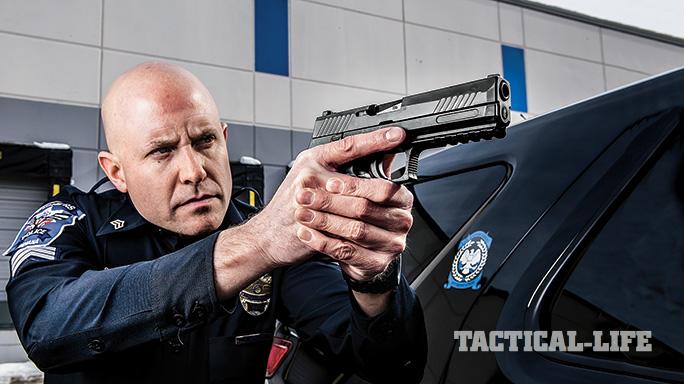Sig Sauer P320 controversy: Separating fact from fiction in safety claims
Despite lawsuits and viral claims, evidence points to training and handling — not design flaws — as the real factors behind P320 safety concerns
By Donald J. Mihalek
Police 1
Aug 29, 2025
A police officer aims a Sig Sauer P320 handgun
On July 20, 2025, Airman Brayden Lovan, 21, of the 90th Security Forces Squadron, was fatally shot during duty hours at F.E. Warren Air Force Base in Wyoming. Initial claims suggested his issued Sig Sauer M18 pistol, the military version of the P320, discharged unintentionally, prompting Air Force Global Strike Command to pause use of the sidearm across its units. That incident reignited ongoing concerns about the M18/P320’s drop safety and potential for unintentional discharge.
However, investigators later arrested another airman on charges including false official statement, obstruction of justice and involuntary manslaughter. This shifted scrutiny away from the firearm and suggested the M18/P320 may not have malfunctioned as originally alleged.
Which raises the question: Are the continuing allegations about the P320’s safety valid?
SIG Sauer pistols have long been regarded as reliable and battle-tested sidearms. From the Navy SEALs’ trusted P226 to the U.S. Secret Service’s .357 SIG P229, these platforms have earned their reputations through decades of dependable service. Now, SIG’s striker-fired, modular P320 platform — chosen by the U.S. military and many law enforcement agencies as their official sidearm — remains under scrutiny. Despite rigorous testing and widespread use, allegations continue to circulate online and in courtrooms claiming the P320 is prone to unintended discharges.
Designed and tested to the highest standards
The P320 was engineered and tested to meet or exceed the most stringent industry safety standards, including NIJ, SAAMI and MIL-STD-810G protocols. It also underwent exhaustive in-house and end-user agency testing by organizations such as the FBI and the U.S. military.
Testing involved trigger performance, accuracy, metallurgical inspections, malfunction assessments and comprehensive drop testing. These protocols require any serious malfunction to trigger re-engineering and resubmission. According to SIG Sauer, no evidence has ever emerged to indicate the P320 can fire without a trigger pull.
Viral videos and clickbait narratives about the Sig Sauer P320
Despite this record, social media platforms and clickbait videos continue to stir skepticism. Some claim to show P320s firing without trigger activation. Videos, however, are not scientific tests. In the era of video editing and out-of-context clips, officers and agencies should view these with a critical eye.
As many officers know, there are always three sides to every story: one version, another and the truth — often somewhere in the middle. Video clips rarely tell the whole story, and claims should always be weighed against empirical data.
Lawsuits and legal findings
Several lawsuits have alleged the P320 discharged without a trigger pull, but outcomes show nuance:
- In Puerto Rico, a case was dismissed after the plaintiff admitted to pulling the trigger.
- In Massachusetts, a jury found the P320 defectively designed but awarded no damages, noting the plaintiff “voluntarily and unreasonably used the P320 pistol knowing that it was defective and dangerous.”
- In other cases, plaintiffs admitted the possibility of external forces or objects engaging the trigger.
Agency investigations and continued use
Agencies that conducted their own tests — including the FBI — have been unable to reproduce unintentional discharges. After an alleged accidental discharge involving the Michigan State Police, the FBI and SIG engineers conducted joint testing and concluded the P320 did not fail. Michigan State Police continues to issue the pistol.
Similarly, despite internal DHS memos suggesting ICE might suspend P320 use, ICE extended its P320 contract for another two years. DHS has never raised formal safety concerns.
Learning from history: Glock faced similar claims
SIG Sauer is not the first firearms manufacturer to face scrutiny. Glock faced similar allegations in the past. Investigations revealed many incidents occurred during disassembly when users failed to properly clear the chamber before pulling the trigger.
These examples underscore a consistent truth: the majority of accidental discharges stem from human error, not mechanical failure. Negligence, improper training or unintentional trigger activation are often at the root.
Training and handling are paramount
The P320 is designed for professionals who require rapid, reliable firing and quick target reacquisition. That design also demands proper training and discipline.
Among the millions of P320s in circulation, there have likely been countless unreported drops in training and operations. Yet there has not been a single verified case of discharge under those conditions. Most complaints appear to occur in off-duty or personal use scenarios, raising questions about context and handling.
In firearms, as in all law enforcement tools, safety is a shared responsibility between manufacturer and user. With consistent training, adherence to protocols and situational awareness, modern service pistols — including the P320 — remain among the safest and most reliable tools available to officers today.
Officer takeaway
For officers, the P320’s track record highlights the importance of training and discipline. Proper handling practices remain the most effective safeguard against unintentional discharge.

1 comment:
I don't agree with this, at least not 100%. There are a fair number of heavily witnessed incidents, some of which are on recorded surveillance, of the weapons discharging in the holster when the person wearing the gun has their hands NOWHERE NEAR the weapon. SIG is blaming these on poorly chosen or defective holsters. They MAY be right. It has yet to be fully explored or adjudicated. ( I own three SIG pistols. NONE of them are any variant of the P320. )
Post a Comment